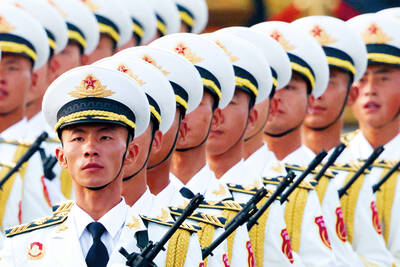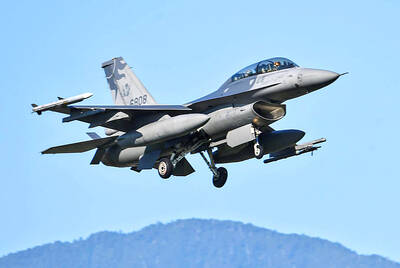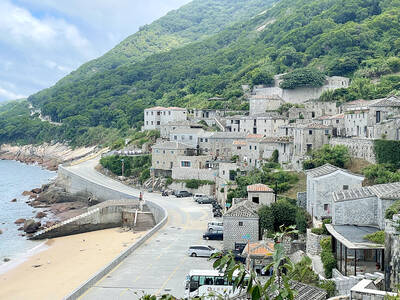The navy's plan to build a mini-AEGIS ship -- which has been shelved for eight years -- is likely to be resumed if local shipbuilders prove they can handle the task, defense sources have said.
The mini-AEGIS building plan, known in the navy as the Advanced Combat System (ACS) project, would not, however, be the same plan as that initially drafted in the late 1980s, if it were to be revived.
The state-run China Shipbuilding Corp, which was the navy's only choice for the building of the mini-AEGIS before the project was put on hold, now has to start from scratch and prove to the navy that it can build such a ship.
The ACS project was stopped in 1994 when Admiral Nelson Ku (顧崇廉) was the commander-in-chief of the navy. Ku has retired from the navy and is now a lawmaker with the PFP.
Ku is generally believed to have played a key role in the shelving of the ACS project, which led him to become the target for criticism every time the ACS issue was brought up.
But former defense minister Wu Shih-wen (世文), who followed in Ku's footsteps to take charge of the navy, hinted in an interview published in the latest issue of the Defence International magazine that his role in the matter might have been no less significant. Wu was the deputy chief of the general staff while Ku was the navy chief.
Regardless of who was responsible for holding up the ACS project, many naval officials share the same view that the navy missed a good chance to own an indigenously-built advanced fighting ship before 2000.
According to the initial plan, the mini-AEGIS would have been built in 50 months. If construction had started in 1994, it could have become operational before 2000.
The ACS project was originally drafted by a group of highly-educated naval officials led by the late Captain Yin Ching-feng (尹清風).
Yin, who was then head of the research and development department at navy general headquarters, was in charge of the case from the beginning.
He completed the draft of the project before he was transferred to lead the weaponry procurement office of the navy general headquarters.
Yin was murdered in late 1993, but the navy was ready by then to start construction of the mini-AEGIS on the basis of the Chenkung-class frigate that China Shipbuilding had built for it.
The plan at the time was to lengthen the hull of the Chenkung-class frigate by 50m so that the ship would have enough room for more weapon systems and larger equipment.
The hardware recommended for installation in the mini-AEGIS included: A smaller version of the SPY-1 phased array radar, a five-inch gun, a vertical launch system for the Standard SM-II missile or the locally-developed TC-II missile, a Harpoon anti-ship missile and a towed sonar.
The list might have to be changed if the ACS is revived since the design is over 10 years old.
* The mini-AEGIS building plan is known as the Advanced Combat System project.
* China Shipbuilding Corp was chosen to build the ship.
* The ACS project was halted in 1994.
Source: Taipei Times

The Chinese military has built landing bridge ships designed to expand its amphibious options for a potential assault on Taiwan, but their combat effectiveness is limited due to their high vulnerability, a defense expert said in an analysis published on Monday. Shen Ming-shih (沈明室), a research fellow at the Institute for National Defense and Security Research, said that the deployment of such vessels as part of the Chinese People’s Liberation Army (PLA) Navy’s East Sea Fleet signals a strong focus on Taiwan. However, the ships are highly vulnerable to precision strikes, which means they could be destroyed before they achieve their intended

The first two F-16V Bock 70 jets purchased from the US are expected to arrive in Taiwan around Double Ten National Day, which is on Oct. 10, a military source said yesterday. Of the 66 F-16V Block 70 jets purchased from the US, the first completed production in March, the source said, adding that since then three jets have been produced per month. Although there were reports of engine defects, the issue has been resolved, they said. After the jets arrive in Taiwan, they must first pass testing by the air force before they would officially become Taiwan’s property, they said. The air force

GLOBAL: Although Matsu has limited capacity for large numbers of domestic tourists, it would be a great high-end destination for international travelers, an official said Lienchiang County’s (Matsu) unique landscape and Cold War history give it great potential to be marketed as a destination for international travelers, Tourism Administration Director General Chen Yu-hsiu (陳玉秀) said at the weekend. Tourism officials traveled to the outlying island for the Matsu Biennial, an art festival that started on Friday to celebrate Matsu’s culture, history and landscape. Travelers to Matsu, which lies about 190km northwest of Taipei, must fly or take the state-run New Taima passenger ship. However, flights are often canceled during fog season from April to June. Chen spoke about her vision to promote Matsu as a tourist attraction in

PAWSITIVE IMPACT: A shop owner said that while he adopted cats to take care of rodents, they have also attracted younger visitors who also buy his dried goods In Taipei’s Dadaocheng (大稻埕), cats lounging in shops along Dihua Street do more than nap amid the scent of dried seafood. Many have become beloved fixtures who double as photography models, attracting visitors and helping boost sales in one of the capital’s most historic quarters. A recent photo contest featuring more than a dozen shop cats drew more than 2,200 submissions, turning everyday cat-spotting into a friendly competition that attracted amateur and professional photographers. “It’s rare to see cats standing, so when it suddenly did, it felt like a lucky cat,” said Sabrina Hsu (徐淳蔚), who won the NT$10,000 top prize in